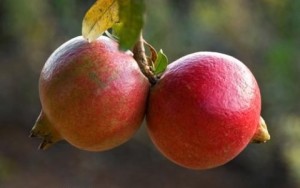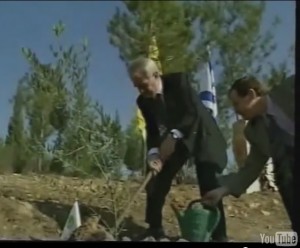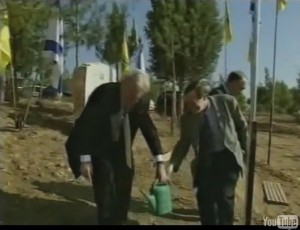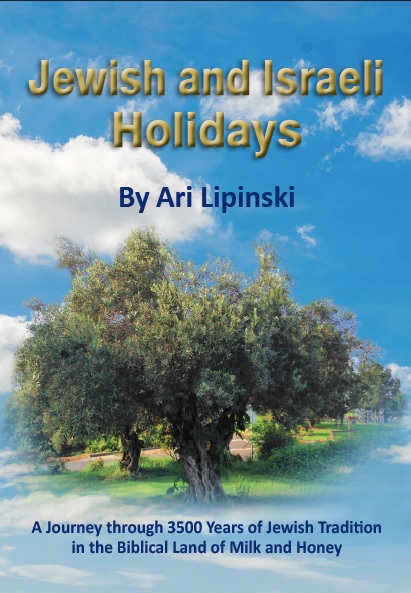Tu Bishvat – The Jewish New Year of the Trees

03 Wednesday Jan 2024
Ari Lipinski TU BISHVAT 26.01.2024 Jewish Press
TU BISHVAT – The Jewish New Year of the Trees
(In Hebrew:Rosh HaShana LaIlanot / Rosh HaShana la Ilan).
Tu Bishvat – the New Year of the Trees explained by Ari Lipinski
(Ari Lipinski was previously the chief delegate in Germany of Israel’s Afforestation Organization KKL.
Tu Bishvat is called in Hebrew also Rosh HaShana la Ilan (plural: la Ilanot). It means the New Year of the tree (trees). The Hebrew words Tu Bishvat mean the 15. of the month of Shvat. “Rosh HaShana la Ilan” means the New Year of the Tree.
It says in the Torah book of Leviticus, Chapter 19, verse 23 “And when ye shall come into the land, and shall have planted all manner of trees for food…”(KJV)

The people of Israel have planted in Israel in the last 100 years ca. 240 Million trees. In the week of Tu Bishvat (the new year of the tree) almost every school kid in Israel plants a tree. Israel is the only state in the world which counts today more trees than it had 100 years ago. The tree has a special and high value in the Bible and in the state of Israel today. The founding day of Israel’s Parlament, the Knesset, is on the New Year of the Tree, Tu Bishvat.
In some countries complete forests were cut off in order to plant tobacco plantations or in order to expand the urbanisation. Many roads were built all over the world while reducing the forest and green areas. The protection of the forests as the green lungs of planet earth are of extreme importance for the existence of all living species including us humans. Therefore the Jewish New Year of the Tree, Tu Bishvat, is of universal importance.
Many tourists coming to Israel take the opportunity to plant a tree with their own hands in the land of the Bible. Israel honors important guests from the world with planting a tree during their Israel visits. Here as an example Ari Lipinski with German PM of NRW Johannes Rau (just before he became German President) at planting an olive tree, the symbol of peace, near Beer Sheba in the Negev desert.
So we have some good reasons to learn more about the special New Year of the Tree, Tu Bishvat.
The Jewish calendar contains since the biblical time 4 different dates which are called a New Year: Rosh HaShana on the first of the month of Tishrei, Tu Bishvat on the 15th of the month of Shvat, the New Year of the Kings on the 1st of the month of Nissan and the New Year on the 1st of the month of Elul. Three of these a. m. dates (except for the 1st of Nissan) served also originally to calculate the tithe, as the 10 % tax out of the agricultural harvest.
The first and most well known among the four dates called a New Year is Rosh HaShana. It marks the beginning of the calendar year on the first of the month of Tishrei which is in autumn (September / October). In Israel of today Rosh HaShana is an official state holiday when all businesses are closed. According to the Jewish-Biblical tradition this day marks the day on which Adam (the first man) was created by God. It was the sixth day of the creation in Chapter 1 of Genesis. Rosh HaShana served during the biblical era to calculate the tenure of the kings of Israel and Judea. It further determined the timetable for the pilgrimages to the temple on the three major holidays Sukkot (Tabernacles), Pessach (Passover) and Shavuot (Pentecost). As a result Rosh HaShana was crucial to determine the seventh year as the Shemita year (Sabbath year, which means “release” year) the therefore also determining the important 50th year of Jovel (Jubilee year). Rosh HaShana was the basis for the calendar determination of dates concerning the age of new plantings thereby serving to calculate the harvest of the field and of vegetables. So we keep in mind that Rosh HaShana provides the basis for the estimation of the biblical Tithe (one tenth) of the harvest of vegetables of the field, whereas Tu Bishvat was used to calculate the Tithe of the fruit of the trees.
The second New Year is Tu Bishvat, the New Year of the Tree, which is in winter (end of January / February). Tu Bishvat is the deadline to estimate the Tithe of the fruit of the trees as well as to determine the “Bikurim” (The First Fruits) of the Seven Species of the Land of Israel which had to be brought to the Temple in the period between Shavuot (Pentecost in spring is also called in Hebrew Chag HaBikurim, the Holiday of the First Fruits.) and Sukkot (Tabernacles in autumn is also called in Hebrew Chag HeAssif, the Holiday of the collected Harvest).
The Seven Species of the Land of Israel listed in the Torah are: Wheat, Barley, Fig, Date, Pomegranate, Olive and the Grape.
On the First Day of the month of Nissan began the calendar year for counting the tenure of kings. “ 1 And the LORD spoke unto Moses and Aaron in the land of Egypt, saying. 2 This month shall be unto you the beginning of months; it shall be the first month of the year to you.” (KJV.)
On the First of the Month of Elul (in summer) begins the year relevant for the estimation of the Tithe related to livestock. This date was defined by the Rabbis of the Mishna era.
Tu Bishvat served during the Mishna era as the relevant date for calculating the aspects related to the fruit picking. Vsarious commandments of the Torah defined the regulations of the Tithe (10% taxation). The Tithe was necessary during the biblical temple era in order to provide for the Kohanim (the Priests), the Levites and the poor people.
The Tithe was a commanded regulation from God. It was required since the priests and the whole tribe of Levi dedicated all their time to the religious rituals mainly related to the tabernacle and later in the Jerusalem Temple. They did not get any pieces of land as other tribes, so they did not have the necessary agricultural resources required to earn for their living.
As long as the Children of Israel were in the Sinai Desert God provided them with food such as manna, water and even meat of the quails.
The regulations of the Tithe related to the agricultural earnings of the Israelites in the Land of Israel. The actual implementation started fully just a number of years after the conquest of Canaan by Joshua, only until the Israelites could count their own harvest and picking in the Promised Land. For example we learn that the Shemita year was implemented probably only 14 years after the entry into Canaan.
Because the natural agricultural earnings from harvest of wheat and vegetables or of fruit picking and from the livestock could be collected only at different points in time during the year, it became necessary to determine different calendars relevant for the calculation of the Tithe in each category. Therefore different New Year dates became unavoidable.

Tu Bishwat was defined during the Mishna era by the rabbis as the date relevant for calculating the Tithe from the fruit picking. The decision resulted from heated discussions among the 71 rabbis of the Sanhedrin after the distruction of the second Temple. Actually the supporters of the rabbi Shamai school wanted the first of Tevet to be the date. Finally the followers of the more liberal school of rabbi Hilel decided in favor of the 15th of Tevet. Therefore the New Year of the Tree is called Tu Bishvat. The preference of the “House of Hilel” (Beit Hilel) is valid until today.
In the Babylonian Talmud in the Rosh HaShana treaty/section, chap. 1, verse 1 we read about the famous discussion between the rabbis of the Shamai house (Beit Shamai) and the rabbis of the more liberal house Hillel concerning the exact date of the New Year of the Tree:
The Shamai rabbis favored the first of the month of Shvat where as the rabbis of the house of Hillel argued that it should be on the 15th of the month Shvat, the Tu Bishvat. (The word Tu is the abbreviation of two Hebrew letters, Tet and Vav, making the date number 9 + 6 = 15.)
The Hillel – School Rabbis argued that concerning the ending of the main rain season as well as relating to the buds of the fruit trees the 15th of Shvat should be the decisive date concerning the tithe considerations.
It is important to understand that the biblical rules and their interpretations by the leading Rabbis of the Mishna-era concerning Tu Bishvat were of great importance also because the fruits of the trees were not to be eaten in the first four years after the planting of a tree.
Why was the determination of the tree related calendar so important?
Answer: In order to calculate the taxation of the tithe it had to be taken into account that counting the ripe fruits in the middle of the fruit picking high season should be avoided. Otherwise the important work would be delayed and disturbed. Also the farmers had to know since what point of time their fruits were permitted for consumption. Having these practical considerations in mind it was decided to implement the counting at the beginning of the spring by counting the buds early instead of counting the fruits later. (“The tax rate” of 10 % already took into consideration that some of the buds would not end up in the fruit finally collected. It was clear to expect some normal rate of loss between buds and ripe fruits.)
With regards to the tithe there are compulsory portions as well as donation options. The 10 % tax is called in the Torah “Maasser Rischon” (the first tithe). It related to 10 % of all fruits, which the owner of the field / plantation brought to the Levites. Further the Bible refers to “Teruma Gedola” (big donation). The Rabbis of the Mishna era estimated this donation as ca. 2 % of the agricultural earnings. This donation the owner gave to the priests. The further donation aspect of the tithe (not the big donation) which is called “Maasser Teruma” related to 1 % of all fruit. Practically it was a tenth of the tithe, which the Levites received from the field owners. So 10 % of what the Levites got was dedicated to the priests (Cohanim). We remind, that only a small part of the tribe of Levi were active as priests. A Cohen (in plural Cohanim) was in any case a Levite. But not every one from the tribe of Levi was a priest.
In addition to the “Maasser Rishon” (the first tithe) there was a second tithe called also “Maasser Ani” (the tithe for the poor people). In some years the owner of the field / plantation was allowed to consume this second tithe himself. In other years the owner donated this second tithe as food for the poor people.
Customs and traditions of Tu Bishvat
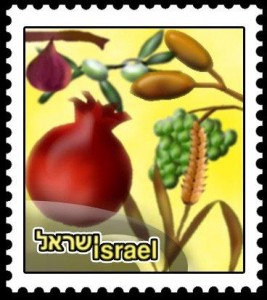
A central custom associated with Tu Bishvat in the land of Israel and also in the exile of Jewish communities abroad is since centuries to arrange the Tu Bishvat ceremonial meal to include elements of the seven species of the land of Israel. This custom was modified in the last 500 years to include 15 sorts of fruits in order to remind of the 15th day in the month of Shvat which is called Tu Bishvat. This tradition is attributed to the famous Kabalistic Rabbi from the city of Safed in the higher Galilee, the AR”I (Rabbi Isaac Ben Shlomo Lurie Ashkenazi, who was called “Ashkenazi Rabbi Isaac”, and lived in the 16th century.
In the land of Israel the custom of planting trees was reinvigorated in 1884 when a group of Zionist Jews planted more then 1500 fruit trees in Tu Bishvat and the days after. This tradition was fostered the more Jews returned to their historic homeland Israel after 1884. Nowadays Israeli children plant in the week of Tu Bishvat over 600.000 trees all over the country! The three major tree nurseries of the KKL (Israel’s afforestation organisation in Gilat near Be’er Sheva (Be’er Sheba), in Eshtaol, in the Jerusalem mountains and at the Golani crossroad in the Galilee produce annually ca. 1,800,000 trees. This year, 5775 according to the Jewish calendar, tree saplings are not distributed for planting because it is a Shemita year, the seventh year in which the ground is not agriculturally cultivated as usual. According to the Torah rules the harvest and the food picking in the Shemita year are not permitted for the Israelites in the land of Israel.
24.3.2017-Abravalel-TuBishvat-
There is a variety of customs and traditions associated with the way Tu Bishvat was celebrated among the Jewish exile communities. They differed from Morocco to Persia or from Yemen to Germany. In previous times food was available according to the season and to the geographic location. Today the global commercial exchange provides people in many countries with any kind of food from anywhere in the world all the time. So one should remember that the composition of fruits previously available to a Jewish community depended very much on its location. In oriental countries people achieved the 15 different kinds of fruits for the Tu Bishvat meal by having various kinds of nuts, almonds and dry fruits. Among them were mainly dry figs, raisins and dry dates. In north European countries a higher proportion of fresh fruits was customary. The community ceremonies differed of course also in the melodies of the Tu Bishvat songs even if the texts were identical because they were taken from the same Psalms or the same Torah sentences. Today in Israel an interesting and colorful synthesis is crystallizing out of the integration of the many traditions. Among the 6 million Jews already living today in Israel over 2,6 Millions are “Olim” (immigrants to Israel, who are called “ascenders”) who returned to their biblical homeland from over 120 different countries.
The main characteristics of Tu Bishvat in Israel today are:
- The planting of trees. As mentioned above, during the week of Tu Bishvat Israeli school kids plant over 600,000 saplings all over the country in Kibbuzim and Moshavim and in the cities, in the Galilee mountains, in the Jezreelvally or the Jerusalem mountains, around the sea of Galilee and even in the Negev desert. The joyful planting ceremonies include a lot of singing and Music. Most ceremonies are organized by the KKL, school teachers and the municipalities. But also many people go privately to plant, or even make a short stop on their way during working hours if they pass by a planting location. The Tu Bishvat school day (starting from kindergarden age) is officially devoted to the planting activities which include in most cases a walk or even a trip to a more distant planting location. In many places hundreds and in some places even thousands of people gather at the specially prepared planting areas. Local authorities provide in close cooperation with the leading aforastation organisation KKL the public free of charge the enormous quantities of tree saplings on that day. Just think of the enormous logistic effort involved with the distribution of hundreds of thousands of saplings in a few days to hundreds of locations and the planning ahead of that week with the ground allocation required. Thanks to the visionary drive of the founder of the state Israel David Ben Gurion (who was also PM from 1948 to 1962) the Tu Bishvat plantings developed into a national, practical and educational vehicle for the modern implementation of the vision of the biblical prophets of the regreening of the land of Israel when the children of Israel will return. quote Isaiah . Many people read also the short traditional planting prayer. (The prayer text you may find at the end of this article.) The original basis for these planting activities are written in the Bible book of Leviticus, chap. 19, verse 23 “wenn ihr in das land kommt und allerlei Baeume planzt davon man isst….”.
- The characteristic Tu Bishvat meal includes a variety of fruits and dry fruits including almond and nuts. As mentioned, the idea is to serve 15 sorts of fruits reminding of the date of Tu Bishvat. Many food shops and supermarkets decorate their facilities offering holiday baskets with a wide spectrum of fresh and dry fruits.
- The public kindergardens, schools, the print media and the digital media offer programs concerning the Tu Bishvat Some of them emphasize Bible texts and the commentaries. Others focus on the environmental benefits of Tu Bishvat. Most Israelis are happy that the Biblical tradition of preserving the creation suits perfectly the most modern approach to the environment. In religious schools, highschools and in thousand of synagogues (in Israel and worldwide) the teachings focus on Torah texts and rabbinical commentaries about the Tu Bishvat holiday.
- Seder Tu Bishvat / Haggadah to Tu Bishvat: Similar to the traditional Pessach Haggadah booklets which include the guidelines for the festive meal of the first Pessach evening called the Seder evening (Leil HaSeder) special booklet with optional guidelines for the Tu Bishvat meal is offered with the heading Seder Tu Bishvat or Haggadah for Tu Bishvat. (Haggadah means a story.)
Further stories and illustrations about Tu Bishvat will be added here soon.Please visit this website again soon to see the new elements. Thank you and Shalom.







